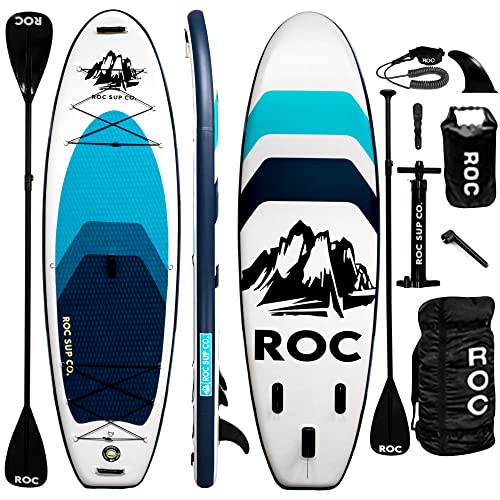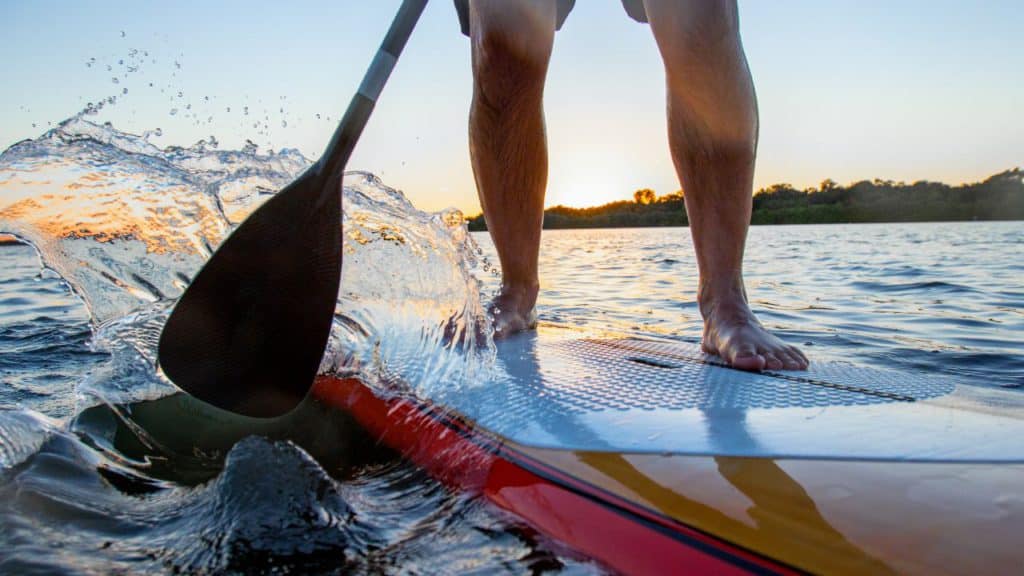Despite the similarity to lake paddling, paddleboarding in the ocean requires more advanced skills and the right gear since you’ll be traversing on open, choppy waters.
In this article, we’ll break down everything you need to know about ocean paddleboarding so you can enjoy paddling without putting your life in danger.
What Is Ocean Paddle Boarding?
Ocean paddle boarding is the same as lake paddle boarding or flat water paddling. The only difference, as mentioned earlier, is that you will be paddling on open and choppy waters.
This change of environment, specifically the body of water (from a lake’s flat and steady waters to the choppier waters of the ocean), means paddle boarding in the sea requires more skills to balance and glide across the water. You will also need to use the right ocean paddle-boarding gear.
Keep in mind that SUP surfing is different from paddleboarding in the ocean. Like traditional surfing, SUP surfing requires you to ride on waves.
Things You’ll Need
Before heading out to the ocean, ensure you have the following gear available. Keep in mind that the equipment you will be using for ocean paddling is similar to lake paddling. However, there is a slight difference, especially with the type of board.
Ocean Paddle Boarding SUPs
For ocean paddling, you can choose between an all-around and a touring paddleboard.
All-around boards are ideal for beginners and great for many locations because of the rounded front and shorter length. However, they are not the best for covering longer distances from the shore.
On the other hand, touring boards have a pointed nose or front and rounded rails, making it easier to cut through choppy waters. A touring board is also longer, adding to speed and stability.
Once you’ve decided which of the two is more suitable for your paddling skills, you’ll also need to consider the following:
- Displacement hull: Having a pointed nose allows the board to easily slice through the water.
- Board width: Larger riders want a wider board, while youth riders can suffice with a narrower board.
- Board length: Longer boards in the 12ft to 14ft range are excellent for speed and downwind traveling. Shorter boards of less than 9ft up to 12ft are easier to turn and handle in the waves.
- Max weight capacity: If you are too heavy than the max capacity, the board can ride lower in the water, making it more difficult to paddle.
1. Roc Paddle Boards Inflatable SUP
This inflatable SUP from Roc Paddle is one of the best options for ocean paddleboarding adventures. This 10ft SUP board has a wide design, offering a broader surface area to confidently stand on and balance when traversing through choppy ocean waters.
Unlike other boards, it only weighs 17.5 pounds, so that you can maneuver it effortlessly. Don’t worry, though. Despite its weight, the Roc Paddle Boards Inflatable SUP is tough. It has reinforced side walls, triple-layer fabric, and support baffles. For your peace of mind, you also get a one-year warranty.

2. SereneLife Inflatable Stand Up Paddle Board
Another paddleboard that you should consider getting is SerenLife’s Inflatable Stand-Up Paddle Board.
It is just an inch narrower than the Roc Paddle, but you still enjoy similar features like high-quality construction and freebies such as a repair patch set, coiled ankle cuff leash, and aluminum paddle.
The difference is that Serenelife has a sharper nose, which gives quicker and smoother tracking with only a few strokes. It can only accommodate a maximum weight of 275lb.

3. Bluefin Cruise SUP Package
This fantastic Bluefin iSUP package is everything an expert could want in a touring paddleboat. It features an advanced carbon composite railing with a drop-stitch interior, making it incredibly durable. Add to that durability with the length reaching a little over 12ft.
The Bluefin’s width reaches a little more than 32″, and the depth exceeds others by nearly 6 1/2in the body. Max weight is around 309lb and inflates to 15psi. Expect high rigidness with the dual air chambers, which double as a safety feature.
The Bluefin differs significantly from the Serenelife and the Roc by length, width, and available accessories in the package. The Roc and Serenelife are shorter and rounder but have the same width and depth. The Bluefin is at least two feet longer than the other boards and adds a few more centimeters to width and depth.

Personal Flotation Device (PFD)
Safety matters on the water; even if you swim well, you need a personal flotation device or a life jacket.
There are many versions of life vests, including those built into fishing vests, scarf-sized, full size and even fanny-pack versions.
A personal flotation device has limitations based on weights, body types, and swimming skills. The best buoyancy for safety and survival is the type 1 device which can turn most unconscious individuals and increase the rate of survival. However, the best life jacket for you is the one you wear consistently.
Fun Fact: The U.S. Coast Guard recommends several versions based on weight and activity.
The Onyx M-16 Belt Pack Manual Inflatable Life Jacket is an excellent choice since it is lightweight and offers a slim fit to avoid interfering with paddling.
The pull tab activates the CO2 chamber to inflate the waist device to provide up to 17lbs of buoyancy. The wearer can also use the inflation tube to increase the buoyancy to 26.5 lb. When inflated, the waistband expands, creating a chest-wide flotation device complete with a halter.
SUP paddle

Having a paddle is essential for ocean paddle boarding. While some board sets include a free paddle, upgrading to a carbon paddle with interchangeable bottoms is a considerable benefit.
Carbon paddles are lighter, so they fatigue your arms less, whereas the interchangeable bases allow you to find the perfect paddle shape for your paddling needs – whether for speed or smoothness.
Rescue Whistle
Having a rescue whistle within reach helps you alert boats, swimmers, and other paddlers when you need assistance. The louder and shriller the noise the device produces, the better.
How Do You Paddle Board in the Ocean for Beginners?
If it’s your first-time to paddleboard, do know that the sea poses an ever-changing threat to beginners. We recommend learning how to paddle board in the ocean before going out in full force. You should also have a paddling buddy; there is safety in numbers.
Here is a brief step-by-step guide:
Check the Conditions
Whether you are a beginner or an experienced paddler, always check the weather forecast before heading out. You should check three things:
- Temperature: 85 degrees or higher is the perfect water temperature for beginners who will most likely repeatedly fall from their boards. For intermediate paddlers, within the 80 degrees range.
- Wind Speed: At 15 knots, the ocean is primarily flat, which is excellent for beginners. On the other hand, intermediate and expert paddleboarders can still go out if the wind is 15-20 knots.
- Tide: Slack tide is the best time for beginners because the tide is stagnant. It occurs twice daily in the hour before and after the low and high tides.
Tip: Check the forecast for signs of incoming storms or rainfall.
Plan the Route
Planning the route of your ocean paddleboarding adventure is crucial to your safety.
As you already know, the ocean is vast. So imagine paddling aimlessly without any planned route – there’s a huge chance you’ll get lost! Before that happens, ensure that you:
- Have a map of the waterways and “water roads” to avoid traffic and know where you can and cannot go.
- Map a route with launching and landing points.
- Share this information with a reliable friend or family member. This information is a float plan and is essential in search and rescue attempts.
Tip: When planning a paddling route, make sure that you first assess your stamina, paddling skills, and fitness levels. If you are a beginner, take shorter and less ambitious routes, as ocean paddleboarding is physically demanding.
Select an Entry Point

You can launch your paddleboard from a dock, the shore, or a boat launch.
A boat launch is ideal for intermediate and expert paddlers because they can easily maneuver away from other vessels. For beginners, opt for the dock or shore with relatively calm waters.
Launch the SUP
The launching of your paddleboard varies depending on your launch location. For a shore or boat launch, you want to:
- Wade to knee-deep water
- Climb on the board by holding the edges
- Kneel or lay on the board
- Paddle away from obstacles and through breakwaters
- Work your way to a standing position.
A deck launch is somewhat easier to accomplish:
- Align the board with the deck
- Sit on the deck with your feet on the board near the handle.
- Slowly move over the board into a crouching or kneeling position.
- Adjust to a kneeling position
- Push away from the dock before attempting to stand.
Stand on the SUP
Once you have mastered launching and kneeling on your board, you can begin to stand.
- Start in a kneeling position and lean forward.
- Place your hands and paddle across the board in front of you.
- Move slowly to put the majority of your weight on your hands.
- Once you are stable, place one foot into place at a time, ending in a low crouch.
- Do not attempt to stand up quickly, as this throws off your balance. Instead, raise your head and chest slowly, then extend your legs.
Balance
Once you have reached a standing position, you must maintain the posture without tiring or losing your balance.
- First, keep your eyes off your feet to help you level.
- Use your lower body to shift against the waves.
- Next, keep your upper body steady.
- Finally, relax your feet, or they tire quickly and become painful.
Ocean Paddleboarding Made Easier
Paddleboarding in the ocean is a fun and exciting way to explore and enjoy the natural water wonders we love. Before heading out, ensure you have the skills, experience, and stamina to tackle the ever-changing ocean.
Table of Contents
